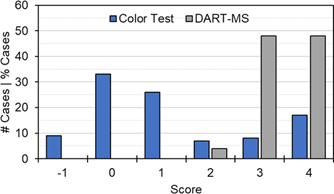With the influx of synthetic opioids like fentanyl and other emerging drugs of abuse (commonly referred to as novel psychoactive substances) into forensic casework over the last several years, laboratories are working on innovative solutions to the challenges of narcotics analysis. Labs are increasingly tasked with processing more complex samples, including those containing more highly toxic chemicals. Current screening methods, such as color tests (which indicate presence/absence of a particular drug class) and gas chromatography with flame ionization (which measures substances in gas steam), are becoming less effective due to the greater complexity of submitted samples. These issues translate into growing burdens on labs, who are already facing mounting backlogs.
While color tests have worked well on simple samples containing traditional controlled substances like cocaine and heroin, they do not provide much information about samples containing fentanyls and other novel psychoactive substances. Gas chromatography with flame ionization (GC-FID) can detect most drugs, but it also has drawbacks, including difficulty resolving drugs with similar chemical structures, challenges in detecting low concentrations of fentanyl (which tends to be found in low concentrations due to its high potency), and the time burden associated with processing these samples, which takes 15 minutes, on average.
Direct analysis real-time mass spectrometry (DART-MS) has the potential to address many of these limitations in traditional analysis protocols.[1] DART-MS drug analysis is more information-rich, more sensitive, less hindered by cutting agents, and better able to distinguish between similar chemical structures than color tests and GC-FID.
NIJ-funded researchers from the Maryland State Police analyzed the current drug evidence analysis caseflow and evaluated whether a re-envisioned workflow employing DART-MS could lead to increased safety, speed, sensitivity, and selectivity in controlled substance analysis.
Workflow Development and Evaluation
For the analysis of controlled substances, researchers focused on two areas to improve upon current methodology:
- Use DART-MS for screening.
- Implement and evaluate re-envisioned workflow.
Researchers created an open-access repository of standard operating procedures to help aid in the implementation of DART-MS technology in other laboratories. They focused their assessment of DART-MS on the following outcomes: accuracy, precision, reproducibility, specificity, sensitivity, environmental effects, and method robustness.
The scientists also created a data-driven gas chromatography mass spectrometry (GC-MS) confirmation method framework. Targeted methods were created for synthetic cannabinoids, synthetic cathinones, and opioids.
Once the re-envisioned workflow methods were established, researchers directly compared current and re-envisioned workflows through blind evaluations of 50 samples designed to test common and challenging cases that have been observed in the laboratory. Four chemists were trained on the equipment, and researchers measured how long it took the chemists to complete their analyses using the two workflows (25 samples with each workflow). Metrics on sensitivities, safety, false positive and false negative rates, and overall performance of the workflows were also examined.
The experimental workflow employing DART-MS greatly reduced the amount of time spent on each sample. Researchers defined and used a scoring system (from -1 to 4, with -1 as an incorrect result, 0 as inconclusive, and 1-4 as increasing levels of correctness) to compare information obtained from the screening steps of each workflow. The analysis indicated that:
- DART-MS results scored, on average, significantly higher (better) than color tests (Figure 1) due to the ability to detect all or most of the compounds present in mixtures and the ability to obtain more specific information about a sample.
- DART-MS did not result in any incorrect identifications.
- DART-MS provided class-level information or better (e.g., cannabinoid, opioid) for all compounds present for all but two samples that received scores of two. In one sample, heroin was not detected above the 5% relative intensity threshold and, in another, cocaine, FIBF, and noscapine were not detected due to low concentrations.
- The average score for the DART-MS results was 3.4 (±0.6) compared to 1.2 (±1.6) for color tests.
New Workflow Implications: Time and Quality Improved
Direct analysis real-time mass spectrometry improved safety, speed, sensitivity, and selectivity over traditional colorimetric tests and GC-FID analyses. A targeted method for confirmation using gas chromatography allowed for a more rapid analysis with a higher sensitivity by providing analysts with a more information-rich screening tool.
The DART-MS documentation package facilitates the adoption of these methods by other laboratories. The workflow comparison study the researchers provided can assist labs in estimating the expected gains they might enjoy by adjusting their analytical workflows, though results might not be directly comparable due to differing workflows.
Creating an Internal Standard, Future Work
In addition to validating the value of using DART-MS combined with gas chromatography, researchers also discovered a means of addressing the fact that DART-MS can sometimes falsely identify starches as compounds of interest owing to the fact that they did not produce spectra with a dominant peak (the false identification resulted from noise peaks). To eliminate this concern, researchers incorporated an internal standard to ensure that a dominant peak was present in all samples. The internal standard also acted as a mass calibration check and could be used to tune the sensitivity of the result by varying its concentration.
It should be noted that this work focused on powdered samples, which represent the most commonly encountered substances in casework. Future studies could focus on DART-MS analysis of liquid samples.
About This Article
The work described in this article was supported by NIJ award number 2018-DU-BX-0165, awarded to Maryland State Police, Forensic Sciences Division.
This article is based on the grantee report “Increasing Safety, Speed, Sensitivity, and Selectivity of Controlled Substance Analysis,” (pdf, 42 pages) by Amber Burns and Edward Cisco.


